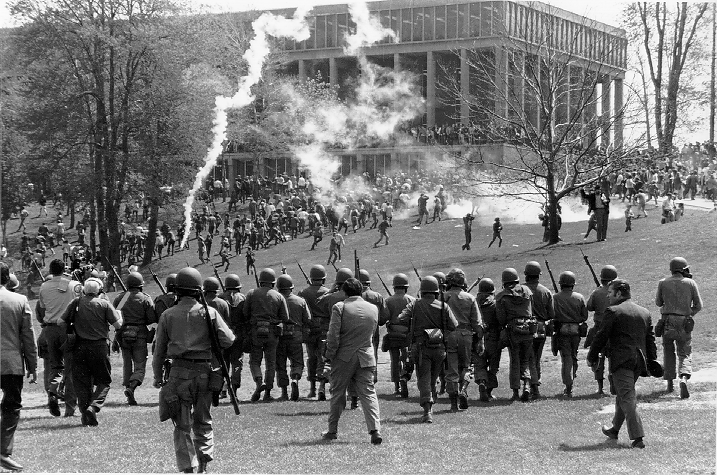American History by Katelyn Woolfolk
The Kent State Massacre
-
On May 4, 1970, a large group of "Kent State University demonstraters" were shot at by the Ohio National Guard, resulting in the deaths of four students. In response to the massacre, students in schools all over the nation went on strike, causing hundreds of universities to close. (Lewis & Hensley)
-
Of the four students killed, two were girls, one of whom was not part of the demonstration, but was walking to class. One of the boys killed was shot in the back. (Lewis & Hensley) One of the boys was also not a protestor. (OHC)
-
The demonstraters were anti-war protestors who were protesting President Nixon's decision to attack Viet Cong by invading (Lewis & Hensley) and bombing Cambodia and therefore making the Vietnam war longer and America's involvement in it greater (OHC). Students at Kent held a rally on the Commons, which had been traditionally used for "various types of rallies and demonstrations." Another meeting was scheduled for that Monday, but the night before, violence broke out in the streets and the police from Kent and the surrounding counties were brought in to subdue the troublemakers. They closed all the bars, and eventually dispersed the students with tear gas, but the night had suffered broken store windows and cars stopped by street bonfires. Governor Rhodes sent for the Ohio National Guard to help quell the further distubances he feared would arise. (Lewis & Hensley)
-
The Monday rally was prohibited by the university, but people still gathered anyway, forming a crowd of about 3000. On one end of the commons stood the main ralliers, on the other, about 100 Guardsmen. "Little evidence exists as to who were the leaders of the rally and what activities were planned, but initially the rally was peaceful." The rally was scheduled to begin at noon, but right before, General Canterbury told the demonstraters to scatter. When this order (shouted by a policeman) was met with rebellious shouts and rocks being hurled at the police, the National Guard took action and tried to break up the crowd with tear gas. The demonstraters moved over a hill to a parking lot, but did not disperse. The Guard tried to reach the students, but were repelled by the rocks, and seemed to be retreating up the hill when they suddenly turned around and fired their guns in all directions. It only took 13 seconds and about 61 to 67 shots, but by the end of it, four students were killed and nine injured, some horribly. (Lewis & Hensley)
-
The twenty-nine National Guardsmen who fired were later tried in court, but always claimed that they fired in self defense, since they felt their lives were threatened. (Lewis & Hensley)
-
This was the first incident of protestors being killed after the Cambodian invasion, but it wasn't the last.
Only days later, two students at Jackson State University were killed at a demonstration. (Brinkley) The Kent State Massacre serves to show just how passionate and dangerous protestors during the late 60s and early 70s could be, and how much conflict was going on within America because of the war in Vietnam.

Sources:
-
Lewis, Jerry M., and Thomas R. Hensley. "THE MAY 4 SHOOTINGS AT KENT STATE UNIVERSITY: THE SEARCH FOR HISTORICAL ACCURACY." The Ohio Council For the Social Studies Review, 1998. Web. 16 Mar. 2016.
-
http://www.travelthruhistory.tv/ThruHistory/wp-content/uploads/2014/05/1971.jpg
-
"Kent State Shootings - Ohio History Central." Kent State Shootings - Ohio History Central. Ohio History Central. Web. 18 Mar. 2016.
-
Brinkley, Alan. The Unfinished Nation: A Concise History of the American People. 6th ed. Boston: McGraw-Hill, 2004. Print.
